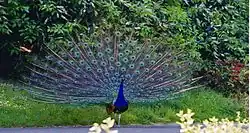孔雀
Chinese
| hole; surname | bird; lentigo; sparrow | ||
|---|---|---|---|
| simp. and trad. (孔雀) | 孔 | 雀 | |

Etymology
孔 (kǒng, “peacock”) + 雀 (què); see 孔 (kǒng).
Pronunciation
Noun
孔雀
- peacock; peafowl (Classifier: 隻/只 m c)
Synonyms
- (literary, or in compounds) 孔 (kǒng)
Derived terms
|
|
Descendants
Sino-Xenic (孔雀):
- → Japanese: 孔雀 (kujaku); 孔雀 (kuzaku)
- → Korean: 공작(孔雀) (gongjak)
- → Vietnamese: khổng tước (孔雀)
Others:
- → Zhuang: gungjcoz
- → Salar: kunse
Japanese
Etymology 1
| Kanji in this term | |
|---|---|
| 孔 | 雀 |
| く Grade: S | じゃく Jinmeiyō |
| goon | kan’yōon |
/kuᵑ sʲakʉ/ → /kuⁿzʲakʉ/ → /kuʑaku/
Ultimately from Middle Chinese 孔雀 (MC kʰuŋX t͡sɨɐk̚).
First cited in the Wamyō Ruijushō of roughly 934.[1]
Pronunciation
- (Tokyo) くじゃく [kùjákú] (Heiban – [0])[2][3]
- IPA(key): [kɯ̟ᵝʑa̠kɯ̟ᵝ]
Noun
孔雀 • (kujaku)
- [circa 934] a peafowl
- Hypernym: 雉 (kiji)
- [1768] (historical, colloquial) a upper-class prostitute especially in Edo-period Yoshiwara
- from their gold-threaded patterns of peafowl, fenghuang, etc. on their fine clothes
- a 家紋 (kamon, “family crest”) with a design of a peacock's expanded tailfeathers
Usage notes
- As with many terms that name organisms, this term is often spelled in katakana, especially in biological contexts (where katakana is customary), as クジャク.
- The genders can be distinguished by using 雄 (osu) and 雌 (mesu), as in 雄クジャク (osu kujaku, “peacock”) and 雌クジャク (mesu kujaku, “peahen”).
Derived terms
Derived terms
- 孔雀王 (Kujaku Ō)
- 孔雀王朝 (Kujaku Ōchō)
- 孔雀貝 (kujakugai)
- 孔雀経 (Kujaku-kyō)
- くじゃく座 (Kujaku-za)
- 孔雀サボテン (kujaku saboten)
- 孔雀羊歯 (kujaku shida)
- 孔雀絞り (kujaku shibori)
- 孔雀石 (kujakuseki)
- 孔雀草 (kujakusō)
- 孔雀染め (kujaku-zome)
- 孔雀炭 (kujakutan)
- 孔雀椿 (kujaku tsubaki)
- 孔雀の木 (kujaku no ki)
- 孔雀の間 (kujaku no ma)
- 孔雀鳩 (kujakubato)
- 孔雀檜葉 (kujaku hiba)
- 孔雀明王 (Kujaku Myōō)
- 孔雀椰子 (kujaku yashi)
- 印度孔雀 (Indo kujaku)
- 薄葉孔雀 (usuba kujaku)
- 沖縄孔雀 (Okinawa kujaku)
- 乙女孔雀 (otome kujaku)
- 小孔雀 (kokujaku)
- 白孔雀 (shirokujaku)
- 紅孔雀 (beni kujaku)
- 真孔雀 (makujaku)
- 舞孔雀 (maikujaku)
- 藪孔雀 (yabukujaku)
Idioms
- 孔雀の卵 (kujaku no tamago)
- 鳶が孔雀を生む (tobi ga kujaku o umu)
Proper noun
孔雀 • (Kujaku)
- (astronomy, colloquial) Short for くじゃく座 (Kujaku-za): Pavo
Etymology 2
| Kanji in this term | |
|---|---|
| 孔 | 雀 |
| く Grade: S | さく > ざく Jinmeiyō |
| goon | |
/kuᵑ sakʉ/ → /kuⁿzakʉ/ → /kuzaku/
A variant shift from Middle Chinese 孔雀 (MC kʰuŋX t͡sɨɐk̚).
First cited in the Utsubo Monogatari of roughly 999.[1]
Noun
孔雀 • (kuzaku)
- [circa 999] (rare, obsolete) a peafowl
See also
- ピーコック (pīkokku, “peacock”)
References
- 1988, 国語大辞典(新装版) (Kokugo Dai Jiten, Revised Edition) (in Japanese), Tōkyō: Shogakukan
- 1998, NHK日本語発音アクセント辞典 (NHK Japanese Pronunciation Accent Dictionary) (in Japanese), Tōkyō: NHK, →ISBN
- 2006, 大辞林 (Daijirin), Third Edition (in Japanese), Tōkyō: Sanseidō, →ISBN
Korean
| Hanja in this term | |
|---|---|
| 孔 | 雀 |
Noun
孔雀 • (gongjak) (hangeul 공작)
- Hanja form? of 공작 (“peafowl”).
Vietnamese
| Hán tự in this term | |
|---|---|
| 孔 | 雀 |
Noun
孔雀
- chữ Hán form of khổng tước (“peafowl”).